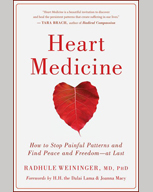Radhule Weininger has made a career of understanding the heart in light of Buddhist teaching and psychotherapy. We reviewed her book, Heartwork, in 2017. She is based in Los Angeles and Santa Barbara, California, where she leads meditation groups and retreats.
In this new book, she seeks to help people who face what she calls “long-standing, recurrent, painful patterns of hurt.” The acronym LRPP refers to these patterns throughout the chapters. These heart pains can leave us feeling cold and numb. They can cripple us and leave us feeling stifled and insecure. As Weininger writes, “I have found myself repeatedly at the mercy of my own patterns of reactivity.”
After a discussion of the most common origins of trauma, how pain can be tied up with the suffering of others, and how freedom from these LRPP is possible, Weininger moves to the core of the book: twelve steps toward healing.
The twelve begin with these five: (1) Recognizing Your LRPP (2) Being Mindful of Body, Thoughts, and Feelings (3) Seeing a LRPP with Self-Compassion (4) Healing Complex Suffering with Compassion for All (5) Creating Mindfully: Setting Clear Intention and Dedicated Motivation.
Thirty-three guided practices throughout the book demonstrate its practicality. These include “Feeling the Felt Sense Practice,” “Recognizing Ourselves Practice,” and “The Heart’s Intention Practice.”
Each practice is easy to follow and to do, and some are very short. Here is the “Mindful Pause Practice: 3 minutes,” recommended for calming down, feeling more grounded, and overcoming tunnel vision in favor of greater connectedness with your surroundings:
“Notice your body.
Exhale to relax.
Recognize your feelings.
Feel the breath of your heart.
Give compassion to yourself.
Return to your breath as refuge.
When ready, return to life.”
This is from Step 6, “When Triggered, Time to Pause.”
Step 7, “Learning to Stay with Your Suffering,” offers teaching for recognizing our suffering, and then facing it in order to relieve ourselves from its grip. Spiritual practices in this vein include “Infirmary Practice (Full-Body Awareness),” “Concentration Meditation,” and “Staying Present Without Running Away Practice.” Each is meant to take ten to fifteen minutes. Each is like “a carefully learned skill, so it’s important to follow the instructions.”
Weininger is a master teacher. Breathing, forgiveness, and service are each a focus of the later steps, offering additional skills designed for facing pain and suffering, and finding freedom and the ability to learn from personal suffering in order to help others.
Forewords by both H. H. the Dalai Lama and Joanna Macy will increase the audience for this important resource.
